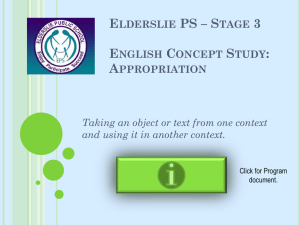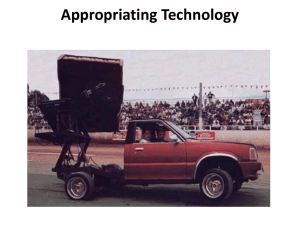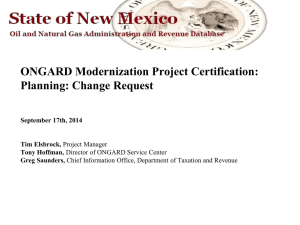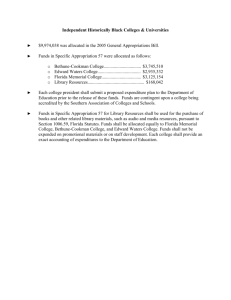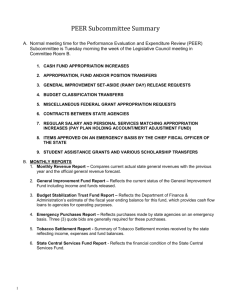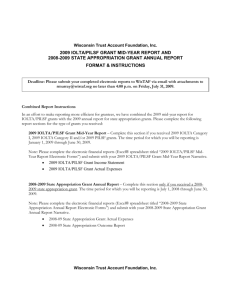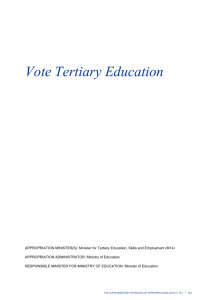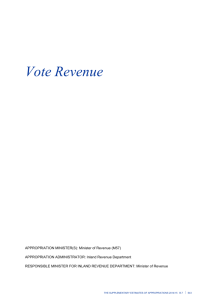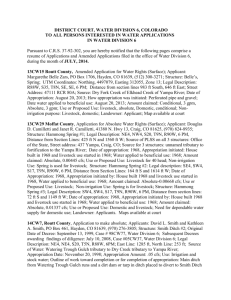Blueprint Outline for UNIV 200 paper
advertisement
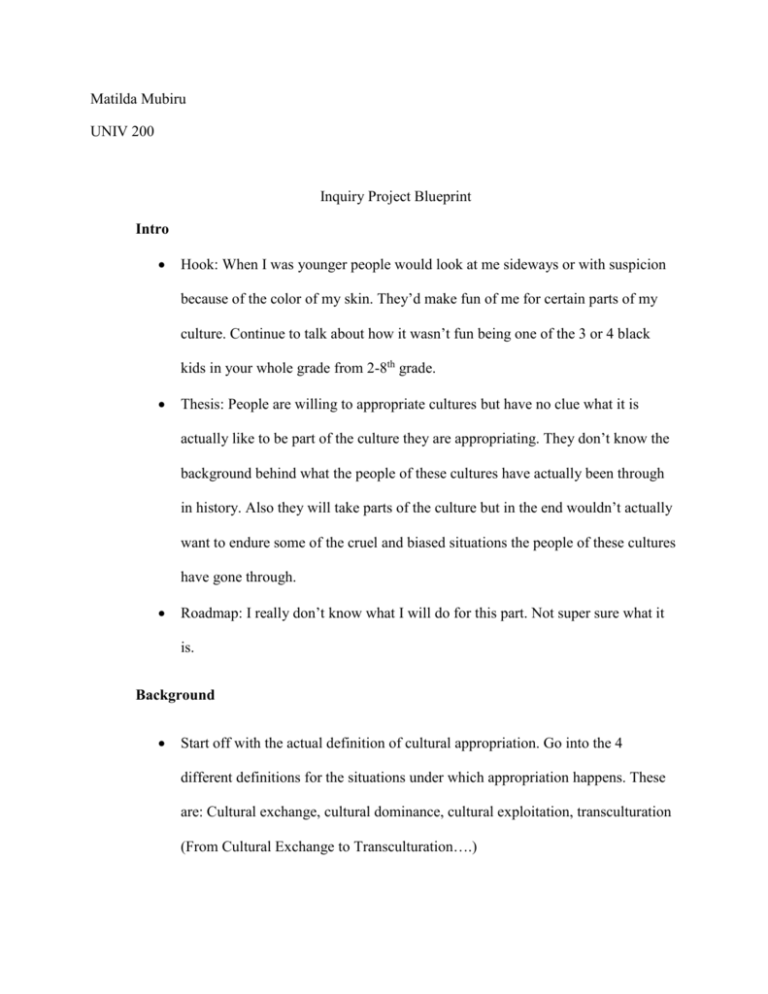
Matilda Mubiru UNIV 200 Inquiry Project Blueprint Intro Hook: When I was younger people would look at me sideways or with suspicion because of the color of my skin. They’d make fun of me for certain parts of my culture. Continue to talk about how it wasn’t fun being one of the 3 or 4 black kids in your whole grade from 2-8th grade. Thesis: People are willing to appropriate cultures but have no clue what it is actually like to be part of the culture they are appropriating. They don’t know the background behind what the people of these cultures have actually been through in history. Also they will take parts of the culture but in the end wouldn’t actually want to endure some of the cruel and biased situations the people of these cultures have gone through. Roadmap: I really don’t know what I will do for this part. Not super sure what it is. Background Start off with the actual definition of cultural appropriation. Go into the 4 different definitions for the situations under which appropriation happens. These are: Cultural exchange, cultural dominance, cultural exploitation, transculturation (From Cultural Exchange to Transculturation….) Talk about how when I was younger I saw some examples of cultural appropriation here and there. As I went to a predominantly white high school I saw instances of it occurring more and more. Mention how cultural appropriation has become more of a common occurrence and all the ways it has become less criticized like it’s a normal thing Reason 1: People appropriating cultures do not know the difference between appropriation and what they are calling “Cultural appreciation”. As well as they don’t take the time to look at the backgrounds of these cultures. “Difference between Cultural Exchange and Cultural Appropriation” article o Cultural exploitation Cultural exploitation commonly involves the appropriation of elements of a subordinated culture by a dominant culture in which the subordinated culture is treated as a resource to be “mined” and “shipped home” for consumption, as in the use of indigenous folk music by Western musicians and companies without financial compensation (Wallis & Malm, 1984). Cultural exploitation includes appropriative acts that appear to indicate acceptance or positive evaluation of a colonized culture by a colonizing culture but which nevertheless function to establish and reinforce the dominance of the colonizing culture, especially in the context of neocolonialism. o Going to use other highlighted areas from under cultural exploitation o Use definitions of cultural exchange, cultural dominance, and transculturation, along with cultural exploitation and elaborate on them. “Reverse Cultural Appropriation” article o This article talks about how they want to claim black people speaking English is cultural appropriation. Highlighted areas talk about some good points o black people wearing business suits” vs let’s say, hipsters wearing headresses, there is a different context and a different meaning that is being produced. We need to look back at history, to context, to culture, to ideology, and to power to really understand what these things are communicating o COLONIZED countries were forced to adopt the culture of the colonizer while their own culture was violently removed. Residential schools, for example, forced indigenous children to speak English, adopt christianity, and were forced to wear European clothes and adopt a European culture. Therefore, it is important to understand the history of colonialism and to understand that what you see as a parallel act of “cultural appropriation,” is really the product of colonialism. o It reiterates the very techniques of colonialism by objectifying someone else’s culture and turning that culture into something available for consumption. It has the effect of making indigenous culture as something belonging to white people by turning indigenous-looking clothes into fashion accessories. o I will use 2 or 3 more of the highlighted sections listed in my diigo account Portions of “Color-Blind Ideology” PDF o examines how white youths culturally appropriate hip-hop by adhering to the demands of color-blind ideology o appropriate hip-hop by removing the racially coded meanings embedded in the music and replacing them with color-blind ones o enabling whites with the discursive resources and racial power to culturally appropriate hip-hop, however unintentionally, for their own purposes. o I’m going to use specific point from pages 4-6 and 10-18. That’s where the best content is Portions of “Dashikis and Face Paint: Decolonizing African culture” o The reason this piece garnered so much support is simple -- colonialism. Attempting to define someone else's Africanness by where they fall on the globe is a direct byproduct of the colonialism that removed Black people from Africa in the first place. It is deeply misguided and disrespectful to disqualify non-native Africans from partaking in African customs and practices solely because of their dislocation from the continent. Such narrow and exclusionary definitions -- cultural and otherwise -- reinforce the colonial separation people across the Diaspora are still grappling o during the Trans-Atlantic Slave Trade, approximately 11,863,000 Africans were shipped across the Atlantic, with a death rate during the Middle Passage reducing this number by 10-20 percent. As a result between 9.6 and 10.8 million Africans arrived in the Americas. o When Black Americans and others within the Diaspora employ aspects of African culture, they do so in an attempt to associate themselves with their long lost homeland. o first generation Africans in America have the privilege of identification and access to customs that Black Americans and others across the Diaspora do not due to their native affiliations Reason 2: They see it as fun and games and use things like holidays and fashion to steal parts they want to use from those cultures for their own enjoyment or profit. “Halloween: Season for Culturally Approrpriating…” article o And this is why it is so dangerous to "dress up" as another culture, because a white person who dresses up as a "Mexican" in Arizona doesn't have to worry that his citizenship will be questioned. He can go to a "ghetto" party and wear his hoodie up in an effort to look more "hood" without fearing that he will get killed like Trayvon Martin. A white student who goes to a bar dressed in blackface doesn't have to worry about being turned away for no reason other than the color of his skin. He doesn't have to face the reality that when there is a hurricane, he will be wrongly labeled as a looter and then identified as a "refugee," a misplaced citizen. o the "Navajo" shirts that Urban Outfitters sold that essentialized the many different American Indian, Alaska Native and Native Hawaiian people in the United States into one broad "Native" tribe defined as Navajo. It is the sports mascot that reduces an entire group to their skin color. It's the celebration of Columbus Day as a day in which Columbus "discovered" a country that had been inhabited by indigenous people for years, and the erasure of the acts and policies of enslavement. It's the Victoria's Secret 'Geisha' lingerie line that featured white models in Orientalist eye makeup and outfits, which in the words of blogger Nina Jacinto, only perpetuates the stereotype of Asian women as objects of sexual fantasy, trading in "real humanness for access to culture o You wear the costume for one night, we wear the stigma for life" o , We ARe not a Cosume We are a Cultre Campaign “Fashion Cultural Appropriation Debate” article or some portions of it o They say the cultural appropriation vs cultural appreciation argument is pointless because people usually just let it dwindle off until the next example comes up and becomes more popular. The author also says it’s pointless because all the history or points for each argument aren't always made Reason 3: Choose to be silent when it matters and do not defend and show support for the cultures they appropriate. Want the “cool” and “hip” aspect but not all the things that come with the culture Article on Amandla Stendberg and how she used social media to speak up about how people will use parts of a culture but do not want to speak up when it matters most. Made good points and this is where she basically called Kylie Jenner out for wearing hairstyles black women use but she never defends or speaks out for us. Portions from “Color-Blind Ideology” PDF o Most likely I will find the portion where the author mentions people wearing certain items, talking a specific way, and things of that nature to be “cool”/ taking the “cool” aspects of say African American culture but not actually wanting/ they wouldn’t want to go through the things we go through Counterclaims Talk about how all these people claiming cultural appropriation sometimes aren’t even the culture who has been appropriated Article “You Can’t Steal A Culture” Not doing it to be “cool” Claiming it is “cultural appreciation” or exchange Conclusion Start with restating what cultural appropriation is basically Talk about how it affected people of different cultures and how the value is their culture was not appreciated Get a poppin quote to use Mention how it affected me End it with a question
